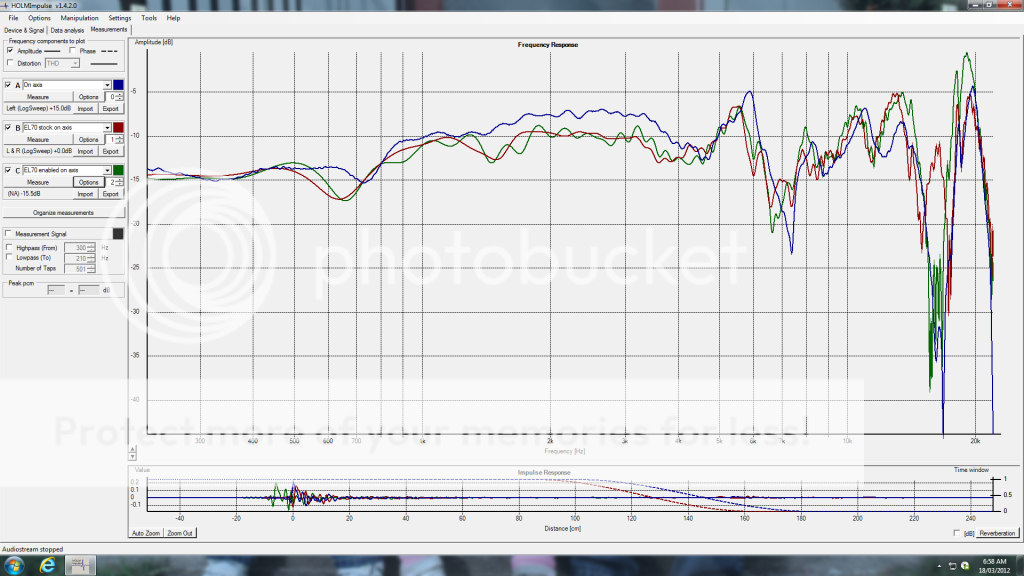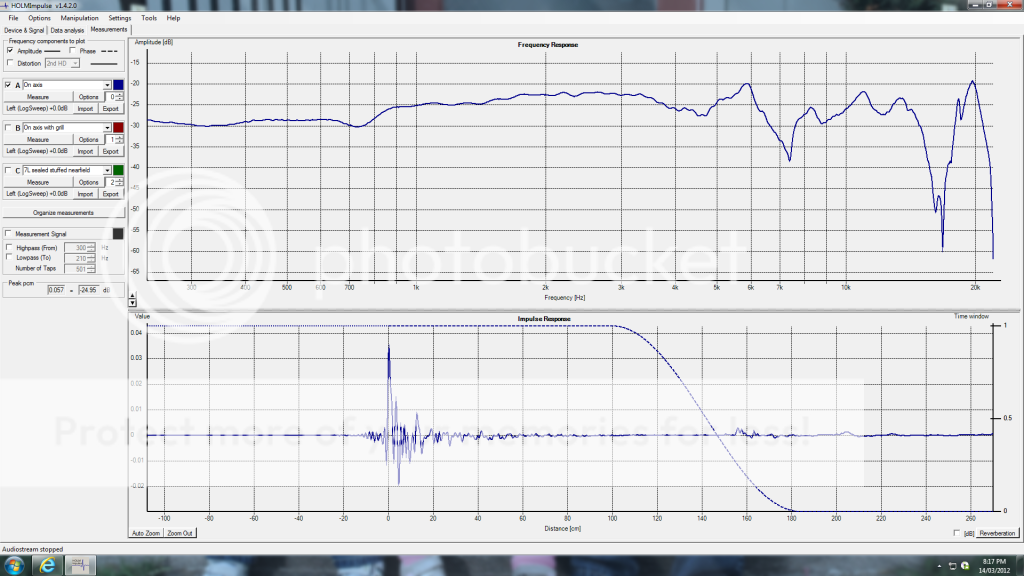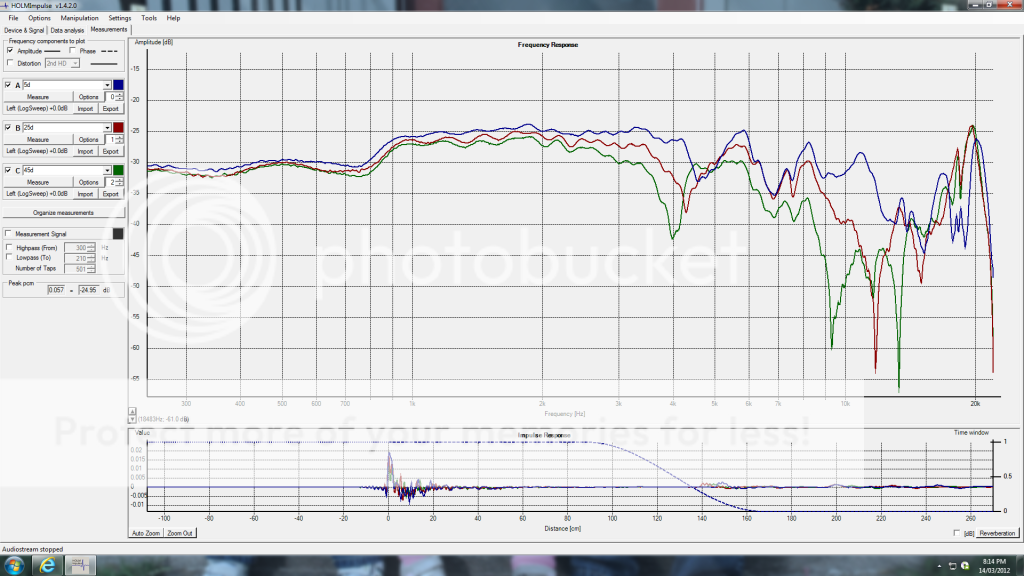Here is 3 different EL70s, red and green in one of Planet10s boxes, blue in a little sealed box.

As you can see, things get ugly up over 4khz. Personally I don't feel the need for a tweeter. Others say they do. I do however find the beam a lot. So if you need more dispersion or you listen off axis, this may be related to you desire for a tweeter.
I just looked at my ERT26 measurement and it does have a small dip around 13khz. Not bad though. I just looked at my Vifa measurement and it also had a dip, albeit a little less than the ERT26. But my Dayton measurement has a peak in the upper octave. Will you hear those? Nope. We can take a lot of frequency aberation in the top octave.
FWIW, I crossed the Vifa and the ERT both down around 2khz without much fuss. I wouldn't let that ND20 down much below 4khz. I did a 6th order (36db/octave) at 3500hz with it, iirc. That was active, the others were passive.
How does one sound over the other? Can't tell you, they were all different speakers and application, and way up there, it could be just about anything as long as it makes noise.

As you can see, things get ugly up over 4khz. Personally I don't feel the need for a tweeter. Others say they do. I do however find the beam a lot. So if you need more dispersion or you listen off axis, this may be related to you desire for a tweeter.
I just looked at my ERT26 measurement and it does have a small dip around 13khz. Not bad though. I just looked at my Vifa measurement and it also had a dip, albeit a little less than the ERT26. But my Dayton measurement has a peak in the upper octave. Will you hear those? Nope. We can take a lot of frequency aberation in the top octave.
FWIW, I crossed the Vifa and the ERT both down around 2khz without much fuss. I wouldn't let that ND20 down much below 4khz. I did a 6th order (36db/octave) at 3500hz with it, iirc. That was active, the others were passive.
How does one sound over the other? Can't tell you, they were all different speakers and application, and way up there, it could be just about anything as long as it makes noise.
.....and way up there, it could be just about anything as long as it makes noise.
This was my feeling exactly when I decided to "splurge" on the ancient Sansui AA-2900s.
Well, no photos as of yet, because I would rather drink another beer and listen to Ernie Watts, but I did look at the crossover and after some figuring with an online crossover calc it seems it is a first order crossed at around 6.5k.
Synergy at work here. It is filling in right where the EL70 starts to "roll off", and in the upfiring position it is very sonically inconspicuous.
I am thinking of maybe mounting them in small, wooden spheres and suspending them a few inches above the top-mounted EL70 drivers, which will turn those into omnis...
Synergy at work here. It is filling in right where the EL70 starts to "roll off", and in the upfiring position it is very sonically inconspicuous.
I am thinking of maybe mounting them in small, wooden spheres and suspending them a few inches above the top-mounted EL70 drivers, which will turn those into omnis...
portreathbeach, looking forward to hearing how your project goes. BTW, that VW van project of yours is awesome!
Dave, here are some photos I took this morning with a crappy cell phone camera. The photo of the crossover is blurry, but what you are seeing there is:
- pink/pink-black = terminal leads
- red/black = woofer leads (which are currently not connected to anything)
- white/white-black = tweeter leads
- Rubycon 35v 3.3 uF cap
- 3.3 ohm resistor
- inductor coil of unknown value
The tweeter is 7.3 ohms and the (omitted) woofer is 5.9 ohms. Both are "Sansui" branded.
I suspect the 3.3 ohm resistor is just there to bring the total load to 8 ohms, (and perhaps attenuate the tweeter as well?).
Dave, here are some photos I took this morning with a crappy cell phone camera. The photo of the crossover is blurry, but what you are seeing there is:
- pink/pink-black = terminal leads
- red/black = woofer leads (which are currently not connected to anything)
- white/white-black = tweeter leads
- Rubycon 35v 3.3 uF cap
- 3.3 ohm resistor
- inductor coil of unknown value
The tweeter is 7.3 ohms and the (omitted) woofer is 5.9 ohms. Both are "Sansui" branded.
I suspect the 3.3 ohm resistor is just there to bring the total load to 8 ohms, (and perhaps attenuate the tweeter as well?).
An externally hosted image should be here but it was not working when we last tested it.
An externally hosted image should be here but it was not working when we last tested it.
An externally hosted image should be here but it was not working when we last tested it.
An externally hosted image should be here but it was not working when we last tested it.
Last edited:
I am considering swapping the 3.3 uF cap with a 2.2 uF or 2 uF cap, for a higher crossover point. The EL70 drivers are still fairly strong up to about 10k (although tuxedocivic's measurements give me pause). I might then bypass the 3.3 ohm resistor as well...
Thoughts?
Thoughts?
Last edited:
Erm.. get yourself down to an Audiologists office and have your Hearing measured. Could save a lot of fooling about with your pore speakers ?
Unlikely... any adult male human can hear even close to the range that most typical tweeters can deliver.
However some believe, often with religious zeal, that they can perceive even Ultrasonics. Presumably through their Fundamental Orfices.. Go figure
Unlikely... any adult male human can hear even close to the range that most typical tweeters can deliver.
However some believe, often with religious zeal, that they can perceive even Ultrasonics. Presumably through their Fundamental Orfices.. Go figure
Erm.. get yourself down to an Audiologists office and have your Hearing measured. Could save a lot of fooling about with your pore speakers ?
Unlikely... any adult male human can hear even close to the range that most typical tweeters can deliver.
However some believe, often with religious zeal, that they can perceive even Ultrasonics. Presumably through their Fundamental Orfices.. Go figure
Nonsense. I can hear up into the 14-15k region without issue. I am 42 and I have tinitus which, oddly enough, sounds about like 16k. My 10 and 11 year old daughters can hear well past that, of course, to nearly 18k.
Point is, if my tweeters are filling in from 6.5k to 15k for me, then it is no surprise that I can hear the difference. No magic involved.
Play with a tone generator some time and you might surprise yourself. If you can't hear 14k then you have significant hearing loss (or you need tweeters!)
Last edited:
I've not liked the cap-only method of attenuation when there's a big sensitivity gap.
With a smaller gap it's less of an issue, but if it's 3dB or more I always use at least 1 resistor.
Hi,
Generally I would agree, but the flushmount Dayton looks
particularly well suited to a single cap for around 10KHz
x/o, effectively using a higher x/o point for attenuation.
In this particular case more than 3dB should be fine.
rgds, sreten.
Last edited:
Just been looking at the frequency response graphs on the datasheets for the EL70s and the Dayton ND20FA-6. At 10KHz the EL70 is 85dB and the Daytons are 92dB. This seems quite a bit of difference in sensitivity.
I have a couple of ideas that I will try, I am new to crossovers and speaker matching, so please correct any of my errors I've made here and any other advice is gratefully received.
1) I could put a 6 ohm resistor in series with the Dayton, that would give me -6dB giving me a total of 12 ohms. Now for 12 ohms and a crossover point of 10K, I would add a 1.32uF cap.
2) I could put a 2.5 ohm resistor in series with the Dayton, I would get roughly a 3dB attenuation, and then I have 8.5 ohms and I could use a 1.87uF cap to cross at 10KHz.
3) No resistor at all and use a 1.32uF cap to cross at 20KHz, as this would give me a 6dB attenuation at 10KHz anyway.
I have a couple of ideas that I will try, I am new to crossovers and speaker matching, so please correct any of my errors I've made here and any other advice is gratefully received.
1) I could put a 6 ohm resistor in series with the Dayton, that would give me -6dB giving me a total of 12 ohms. Now for 12 ohms and a crossover point of 10K, I would add a 1.32uF cap.
2) I could put a 2.5 ohm resistor in series with the Dayton, I would get roughly a 3dB attenuation, and then I have 8.5 ohms and I could use a 1.87uF cap to cross at 10KHz.
3) No resistor at all and use a 1.32uF cap to cross at 20KHz, as this would give me a 6dB attenuation at 10KHz anyway.
Option 1 and 3 seem to make the most sense to me, but these options are only really necessary if you do plan to have a front-firing tweeter. I think it is worthwhile to consider that there is a very high likelihood that the speakers will lose a lot of top end coherence in this configuration.
The best option, from all the reading I have done, is to mount the tweeters in the backs of the speakers, with a simple cap to crossover where you want it. Maybe a resistor, too, but backfiring will attenuate significantly on its own...
Forum member Pit Hinder explains... http://www.diyaudio.com/forums/full-range/97312-adding-tweeter-full-range.html#post1147905
That whole thread is very informative, IMO.
The best option, from all the reading I have done, is to mount the tweeters in the backs of the speakers, with a simple cap to crossover where you want it. Maybe a resistor, too, but backfiring will attenuate significantly on its own...
Forum member Pit Hinder explains... http://www.diyaudio.com/forums/full-range/97312-adding-tweeter-full-range.html#post1147905
That whole thread is very informative, IMO.
Last edited:
Thanks for your responses, so at least in theory my calculations were OK, so at least I can experiment and kind of understand what I should be affecting with the various components I am placing.
Cogitech, that thread was an interesting read, thanks.
Sreten, I think the single capacitor (well, 2 parallel caps) is the cheapest and easiest option and looks like it would do the job. I'll have to order up a few caps and wait for the tweeters and caps to arrive.
Cogitech, that thread was an interesting read, thanks.
Sreten, I think the single capacitor (well, 2 parallel caps) is the cheapest and easiest option and looks like it would do the job. I'll have to order up a few caps and wait for the tweeters and caps to arrive.
Cool. I am very much in the learning stages as well. I look forward to hearing how your project goes.
Just yesterday I ordered some 2.2 uF Roederstein caps off e-bay to replace the 3.3 uF I have in the retro crossovers. I think the tweeters could stand to be crossed a bit higher. I might also swap out the resistors for something slightly smaller. I am thinking I will limit the bandwidth to 8k and up, but then add a couple of dB and mount the tweeters backside... I think I will play with all sorts of configurations and see what I like best.
DIY audio is so much fun!
Just yesterday I ordered some 2.2 uF Roederstein caps off e-bay to replace the 3.3 uF I have in the retro crossovers. I think the tweeters could stand to be crossed a bit higher. I might also swap out the resistors for something slightly smaller. I am thinking I will limit the bandwidth to 8k and up, but then add a couple of dB and mount the tweeters backside... I think I will play with all sorts of configurations and see what I like best.
DIY audio is so much fun!
Let me point out the real issue you're fighting with here. Beaming. The EL70 beams quite a bit, which is why you're feeling like it's missing "air" or "sparkle" or what ever it is you're after.
Here it is on axis

Here is 5, 25, and 45 degrees

Because we're in breakup land above 4khz, you can see there is some bunching and spreading depending on the frequency, not nice parallel lines. Not bad though, just ignore the bunching for a while and assume they're parallel.
By 10khz the response is down 5db at only 5 degrees off axis! So what do you think is going to happen when you introduce a nearly omnidirectional tweeter around 10khz? It's going to spray sound all over the place and fill in all that sound that is missing off axis.
Now move back on axis. You have nearly flat response with the EL70, plus all the extra ouput of the tweeter. That's going to sound to bright.
Just beware.
Here it is on axis

Here is 5, 25, and 45 degrees

Because we're in breakup land above 4khz, you can see there is some bunching and spreading depending on the frequency, not nice parallel lines. Not bad though, just ignore the bunching for a while and assume they're parallel.
By 10khz the response is down 5db at only 5 degrees off axis! So what do you think is going to happen when you introduce a nearly omnidirectional tweeter around 10khz? It's going to spray sound all over the place and fill in all that sound that is missing off axis.
Now move back on axis. You have nearly flat response with the EL70, plus all the extra ouput of the tweeter. That's going to sound to bright.
Just beware.
Because we're in breakup land above 4khz
Transition from piston to breakup is actually at 650 Hz. The nature of it is pretty much under control until 4kHz.
Ryan,is that your old EL70 or your new EL70eN?
dave
- Status
- This old topic is closed. If you want to reopen this topic, contact a moderator using the "Report Post" button.
- Home
- Loudspeakers
- Multi-Way
- Adding a super tweeter to a full range